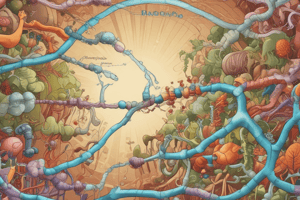Podcast
Questions and Answers
What molecule acts as an activator for Phosphofructokinase-1 (PFK-1)?
What molecule acts as an activator for Phosphofructokinase-1 (PFK-1)?
- Alanine
- Fructose-2,6-bisphosphate (correct)
- ATP
- Citrate
Which enzyme in glycolysis is inhibited by glucose-6-phosphate?
Which enzyme in glycolysis is inhibited by glucose-6-phosphate?
- Phosphofructokinase-1
- Hexokinase (correct)
- Pyruvate Kinase
- Fructose-1,6-bisphosphate
Which of the following indicates a high energy status and inhibits glycolysis?
Which of the following indicates a high energy status and inhibits glycolysis?
- ADP
- Citrate (correct)
- Fructose-1,6-bisphosphate
- AMP
Insulin promotes glycolysis by enhancing which of the following?
Insulin promotes glycolysis by enhancing which of the following?
During hypoxia, what change occurs in glycolysis?
During hypoxia, what change occurs in glycolysis?
Flashcards are hidden until you start studying
Study Notes
Glycolysis: Enzyme Regulation
-
Overview of Glycolysis
- Glycolysis is the metabolic pathway that converts glucose into pyruvate, producing ATP and NADH.
- Occurs in the cytoplasm of cells and consists of 10 enzymatic steps.
-
Key Enzymes in Glycolysis
- Hexokinase
- Phosphofructokinase-1 (PFK-1)
- Pyruvate Kinase
-
Regulation Mechanisms
-
Allosteric Regulation
- Enzyme activity can be modulated by molecules that bind at sites other than the active site.
-
Feedback Inhibition
- End products inhibit enzymes to prevent overproduction.
-
-
Hexokinase Regulation
- Inhibited by:
- Glucose-6-phosphate (its product).
- Ensures glucose is phosphorylated only when needed.
- Inhibited by:
-
Phosphofructokinase-1 (PFK-1) Regulation
- Key regulatory step in glycolysis, highly controlled.
- Activators:
- AMP (indicates low energy status).
- Fructose-2,6-bisphosphate (produced in response to insulin).
- Inhibitors:
- ATP (indicates high energy status).
- Citrate (signals adequate energy supply).
-
Pyruvate Kinase Regulation
- Activators:
- Fructose-1,6-bisphosphate (feedforward activation).
- Inhibitors:
- ATP (indicates high energy status).
- Acetyl-CoA (signals to divert pyruvate to other pathways).
- Alanine (signals sufficient amino acid levels).
- Activators:
-
Hormonal Control
- Insulin:
- Promotes glycolysis by enhancing the activity of key glycolytic enzymes.
- Glucagon:
- Inhibits glycolysis and promotes gluconeogenesis in the liver.
- Insulin:
-
Energy Status Indicators
- High levels of ATP and citrate signal to slow down glycolysis.
- Low levels of ATP and high levels of AMP signal to accelerate glycolysis.
-
Impact of Metabolic Conditions
- Hypoxia:
- Increases reliance on glycolysis due to limited oxygen availability.
- Cancer cells (Warburg effect):
- Prefer glycolysis even in the presence of oxygen, leading to increased lactate production.
- Hypoxia:
Glycolysis Overview
- Glycolysis is a metabolic pathway that transforms glucose into pyruvate, generating ATP and NADH.
- Occurs in the cytoplasm and comprises 10 enzymatic reactions.
Key Enzymes in Glycolysis
- Hexokinase
- Phosphofructokinase-1 (PFK-1)
- Pyruvate Kinase
Regulation Mechanisms
-
Allosteric Regulation
- Enzyme activity can change via molecules binding at non-active sites.
-
Feedback Inhibition
- End products inhibit earlier enzymes to prevent excessive production.
Hexokinase Regulation
- Inhibited by glucose-6-phosphate, its own product, to manage glucose phosphorylation.
Phosphofructokinase-1 (PFK-1) Regulation
- Acts as a key regulatory point, tightly controlled by:
- Activators:
- AMP signals low energy levels.
- Fructose-2,6-bisphosphate, stimulated by insulin.
- Inhibitors:
- ATP as an indicator of high energy.
- Citrate, reflecting sufficient energy supply.
- Activators:
Pyruvate Kinase Regulation
- Activators:
- Fructose-1,6-bisphosphate promotes feedforward activation.
- Inhibitors:
- ATP signals high energy.
- Acetyl-CoA indicates diversion of pyruvate to different pathways.
- Alanine suggests adequate amino acid availability.
Hormonal Control
- Insulin: Enhances glycolysis by increasing the activity of key enzymes.
- Glucagon: Inhibits glycolysis while promoting gluconeogenesis in the liver.
Energy Status Indicators
- Elevated ATP and citrate levels slow down glycolysis.
- Reduced ATP and increased AMP levels prompt acceleration of glycolysis.
Impact of Metabolic Conditions
- Hypoxia: Raises reliance on glycolysis due to oxygen constraints.
- Cancer Cells (Warburg Effect): Prefer glycolysis even with available oxygen, resulting in heightened lactate production.
Studying That Suits You
Use AI to generate personalized quizzes and flashcards to suit your learning preferences.




